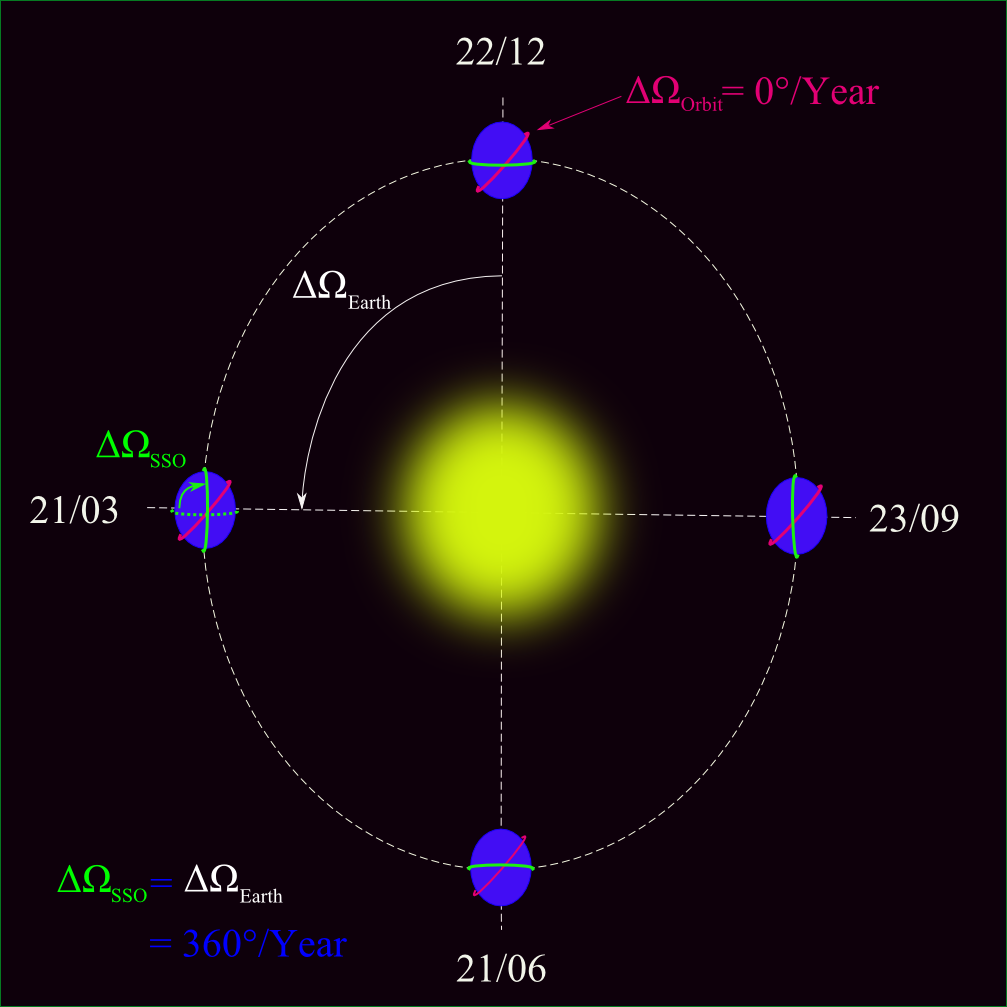Three Classes of Orbit


High Earth Orbit

A Sun-synchronous orbit is a geocentric orbit which combines altitude and inclination in such a way that an object in this orbit has an a nodal regression rate which is equals to Earth’s orbital rotation speed around the Sun. The object in this orbit constantly illuminated by the Sun. Output: Inclination vs Altitude Plot. A sun-synchronous orbit (SSO), also called a heliosynchronous orbit, is a nearly polar orbit around a planet, in which the satellite passes over any given point of the planet's surface at the same local mean solar time.
When a satellite reaches exactly 42,164 kilometers from the center of the Earth (about 36,000 kilometers from Earth’s surface), it enters a sort of “sweet spot” in which its orbit matches Earth’s rotation. Because the satellite orbits at the same speed that the Earth is turning, the satellite seems to stay in place over a single longitude, though it may drift north to south. This special, high Earth orbit is called geosynchronous.
A satellite in a circular geosynchronous orbit directly over the equator (eccentricity and inclination at zero) will have a geostationary orbit that does not move at all relative to the ground. It is always directly over the same place on the Earth’s surface.
A geostationary orbit is extremely valuable for weather monitoring because satellites in this orbit provide a constant view of the same surface area. When you log into your favorite weather web site and look at the satellite view of your hometown, the image you are seeing comes from a satellite in geostationary orbit. Every few minutes, geostationary satellites like the Geostationary Operational Environmental Satellite (GOES) satellites send information about clouds, water vapor, and wind, and this near-constant stream of information serves as the basis for most weather monitoring and forecasting.

- синхронная орбита
Synchronous Orbit Elevation
синхронная орбита
Орбита с периодом обращения, кратным периоду вращения Земли вокруг своей оси.
[Л.М. Невдяев. Телекоммуникационные технологии. Англо-русский толковый словарь-справочник. Под редакцией Ю.М. Горностаева. Москва, 2002]
Тематики
- электросвязь, основные понятия
EN
- synchronous orbit

Synchronous Orbit Calculation
Англо-русский словарь нормативно-технической терминологии. academic.ru. 2015.
What Is A Sun Synchronous Orbit
Смотреть что такое 'synchronous orbit' в других словарях:
synchronous orbit — noun Geostationary orbit • • • Main Entry: ↑synchronal … Useful english dictionary
Synchronous orbit — A synchronous orbit is an orbit in which an orbiting body (usually a satellite) has a period equal to the average rotational period of the body being orbited (usually a planet), and in the same direction of rotation as that body.PropertiesA… … Wikipedia
synchronous orbit — noun (Military) A satellite orbit where the orbital period is equal to, or multiples of, the Earth’s rotational period; i.e. making one, two, three, etc., orbits in a 24 hour period. ::Examples include geosynchronous (period equals Earth’s… … Wiktionary
synchronous orbit — sinchroninė orbita statusas T sritis fizika atitikmenys: angl. synchronous orbit vok. synchronisierte Bahn, f rus. равновесная орбита, f pranc. orbite synchrone, f … Fizikos terminų žodynas
synchronous orbit — A satellite orbit where the orbital period is equal to, or multiples of, the Earth … Military dictionary
Sun-synchronous orbit — Diagram showing the orientation of a Sun synchronous orbit (green) in four points of the year. A non sun synchronous orbit (magenta) is also shown for reference A Sun synchronous orbit (sometimes called a heliosynchronous orbit) is a geocentric… … Wikipedia
Semi-synchronous orbit — Semi Synchronous Orbit: An orbit with approximately a 12 hour period. A circular Semi Synchronous Orbit is at an altitude of approximately 20,200 km. [cite paper | title=NASA Technical Standard 8719.14 (draft) | publisher = NASA Orbital Debris… … Wikipedia
sun-synchronous orbit — An orbit in which the satellite … Military dictionary
Orbit — This article is about orbits in celestial mechanics, due to gravity. For other uses, see Orbit (disambiguation). A satellite orbiting the Earth has a tangential velocity and an inward acceleration … Wikipedia
Synchronous rotation — Due to synchronous rotation of their moon, the inhabitants of the central body will never be able to see its side marked with green. In astronomy, synchronous rotation is a planetological term describing a body orbiting another, where the… … Wikipedia
orbit — I (New American Roget s College Thesaurus) n. path, track, circuit, revolution, course; region, range, sphere, realm, scope; province, sphere of influence. See astronautics, business. II (Roget s IV) n. 1. [Path described by one body revolving… … English dictionary for students
